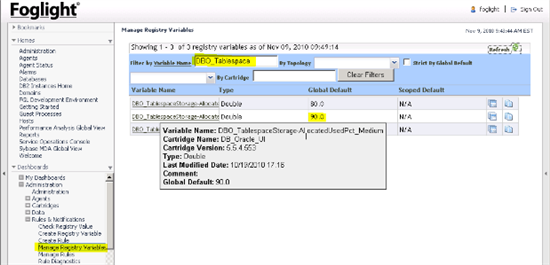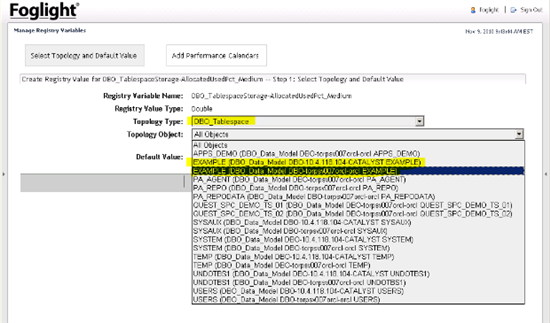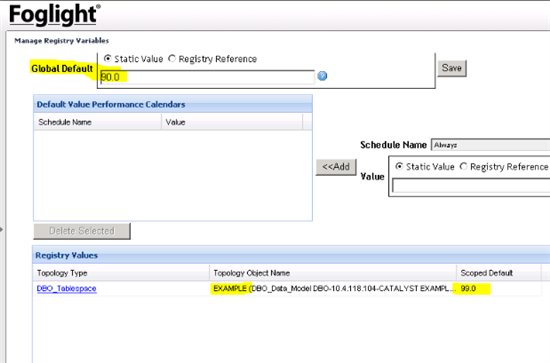Hi,
This is Darren Mallette. I'm a Foglight Solutions Architect specializing in database and virtualization technologies at Quest Software. In Part 1 of this series, we started to investigate how to set different thresholds on the rule that monitors Oracle tablespaces. We navigated through the rules and found that the "DBO - Tablespace Used Pct" rule uses the registry variable "DBO_TablespaceStorage-AllocatedUsedPct_Low" as the threshold for its warning condition ("DBO_TablespaceStorage-AllocatedUsedPct_Medium" is used for the critical severity). In this post, we will look at how to change the value for a specific tablespace.
Since we know the registry variable name, we can navigate to Administration -> Rules & Notifications -> Manage Registry Variables. We can filter on the Variable Name by typing DBO_Table and we see 3 matching variables, and their corresponding global default values. For the warning severity we see 80.0 and for critical, we see 90.0. This will apply to all current and any future tablespaces being monitored.
However, we would like to have a different threshold for the critical severity just for our tablespaces that have "EXAMPLE" in their name. We only want to be warned at the critical severity level if the tablespace is 99% full. To do that, we need to scope the value to that topology object. We start by clicking on the "DBO_TablespaceStorage-AllocatedUsedPct_Medium" registry variable. We then click the "Add Registry Value" button at the bottom of the screen. We start by picking "DBO_Tablespace" from the "Topology Type" dropdown. (We know this from our discovery work in Part 1). Next, all of the Topology Objects of type DBO_Tablespace will load and we look for the "EXAMPLE" values. Since there are 2, we need to pick one, and then repeat the process.
We'll add "99.0" in the "Default Value" field and make sure it's set to a Static Value. (We need the .0 as this is a datatype of double). We'll click Add, and on the Performance Calendars tab, we'll skip any entries and click Done. (We can additionally pick a schedule for a time period for this scoped value to be valid within).
We now see that there is a scoped default of "99.0" for the EXAMPLE tablespace on a specific database (10.4.118.104-CATALYST). Since we had another database with an EXAMPLE tablespace, we need to go back and repeat the steps to add the value for it. Stay tuned for part 3 where we'll explore some Groovy code to automate this process. We'll show how to set the scoped value for all EXAMPLE tablespaces in one shot, and put a process in place to cover any future "EXAMPLE" tablespaces that start getting monitored by Foglight.




